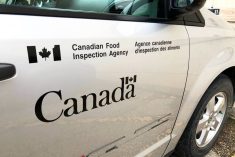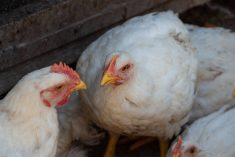Another 93 bidders in the federally-funded hog farm transition program (HFTP) will share in its final allocation of $14.2 million to fold up their hog operations for at least three years.
The Canadian Pork Council, which administers the HFTP on Ottawa’s behalf, reported Tuesday that 93 of 274 bids were accepted for the fourth tender, held March 10, with the lowest bids accepted first, followed by higher bids until the remaining HFTP funds were fully committed.
Of the successful bids, the lowest accepted was $493.80 per animal unit equivalent (AUE); the highest was $888.97 per AUE.
Read Also

U.S. livestock: Hogs, cattle fall
Chicago Mercantile Exchange livestock futures fell across the board on Wednesday. Most-active February live cattle futures closed at 229.550 cents…
(For bids to be compared among all types of animals and facilities, a system to compare bids was developed in which each total farm bid submitted was converted to a dollar per AUE.)
The HFTP, budgeted for $75 million in all, was meant to help eligible producers by providing payments to those who agree to set aside all hog production on their operation for at least three years.
Speaking Wednesday on the pork industry-sponsored program Farmscape, council public relations manager Gary Stordy said the HFTP has reduced Canada’s sow inventory by about 10 per cent.
“In total this program has removed about 137,000 sows and that will have a ripple effect,” he said, in terms of the number of hogs heading to market.
All successful bid packages from the HFTP will be sent out “shortly” including a letter of confirmation that successful applicants must sign and return by April 15, the council said.
“If confirmation is not received by April 15, the bid will be deemed unsuccessful and funds will go back to the HFTP for distribution to other producers,” the council warned Tuesday.
Any residual funds and funds previously allocated to hog farmers who’ve since decided not to participate in the program will also be used to honour bids next in line from the results of the fourth tender, the council said.
“Complete and final results from the fourth tender are expected by April 30, allowing time for reallocation of funds returned to the program by producers who have withdrawn their bids.”
“Expectations”
Those who confirm their participation and want to depopulate their barns or have already left the industry can ask for a 25 per cent advance on their successful bid, Stordy said.
Then, once the barn is empty as promised, and the farmer provides other needed information, the rest of the payment will follow.
“Then, of course, the next step after that is regular reviews and audits of the facilities, to make sure that they’re living up to the expectations of the program — and that is to keep their barns empty for three years,” Stordy said on Farmscape.
The HFTP is expected to create a more noticeable dent in some provinces’ hog production than in others.
The March issue of the ag newspaper Country Life in B.C. notes that the program has helped wind down operations at British Columbia’s two biggest hog production units, Omega Farms of Abbotsford and Sunrise Pork Producers of Dawson Creek.
Omega alone produced about 40 per cent of the province’s weaners, associate editor David Schmidt wrote. One of Omega Farms’ stakeholders, Ritchie-Smith Feeds, is also shutting down its major finishing operations.
“Ritchie-Smith alone represented a quarter of our industry,” B.C. Hog Marketing Association director Rick Thiessen told the newspaper.
Earlier this month, CBC reported that Maple Leaf Foods’ Larsen Packers will shut down its hog processing operations at Berwick, N.S. on March 26, citing “a reduction in Maritime hog production.”
The Larsen plant’s further processing and deli meat operations will remain at Berwick, about 20 km west of Kentville, CBC reported.














